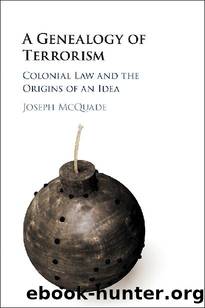A Genealogy of Terrorism by Joseph McQuade

Author:Joseph McQuade [McQuade, Joseph]
Language: eng
Format: epub
Publisher: Cambridge University Press
Published: 2020-11-12T00:00:00+00:00
âThe Appeal of Sikhs Was Specially Obnoxiousâ
Over the first fifteen years of the twentieth century, revolutionary groups in Bengal such as Jugantar and the Anushilan Samiti achieved varying degrees of success in expanding their operations and in staging attacks against colonial informants and imperial officials, most notably in the highly publicized bomb attack against Hardinge by Rash Behari Bose in 1912.36 With the onset of war, these plans became more ambitious, and organizations in Punjab, Bengal, and central India sought to combine their resources to stage an all-India uprising, with Bose as a key organizer. Beginning on 12 February, Bose and his associates began making arrangements for a general rising on the 21st of that month, which was to be modelled after the mutiny of 1857. The Indian Army was the key element of the conspiracy, and revolutionaries attempted to disseminate revolutionary propaganda to troops stationed in Lahore, Rawalpindi, Ferozepore, and Meerut. Furthermore, the revolutionaries prepared bombs, arms, and ammunition, as well as flags, equipment for destroying railways and telegraph wires, and even a formal declaration of war.37
The police foiled the conspiracy by planting a spy named Kripal Singh into the inner circle of the revolutionaries. On 15 February, Singh overheard a conversation regarding the plans for the rising and informed the police. Although Bose realised that Singh was an informant and had the date of the rising moved up to 19 February, Singh was able to escape for long enough to signal his contacts in the CID, leading to a massive crackdown on revolutionary operations across India.38 Following the failure of the conspiracy, Boseâs lieutenant Sachindranath Sanyal attempted to carry on the fight, printing a new Liberty leaflet that implored its readers to honour the sacrifice of those captured by the police. âYou may die any day of plague, cholera or malaria,â Sanyal wrote in the Liberty leaflets confiscated at the time of his arrest. âWhy not die like a man in a noble cause? Look at the Germans who are dying in lakhs for their country. Dwellers in India, you must also die in lakhs.â39 By juxtaposing Indian patriotism with that of the Germans, Sanyal articulated the revolutionary cause through the language of war. He also sought to reframe the defeat of his revolutionary companions as a kind of victory through sacrifice that he hoped would inspire others to join the anti-colonial cause.
Although Rash Behari Bose escaped the widespread crackdown, his co-conspirators, including V. G. Pingle, were prosecuted by Special Tribunal in the Lahore conspiracy trial, where the evidence provided by Kripal Singh played a key role in securing convictions. Singhâs role as a paid police spy initially raised questions about the reliability of his testimony, but it was ultimately concluded that the government were âno doubt justified in employing spies; and ⦠a person so employed [does not] deserve to be blamed if he instigates an offence no further than by pretending to concur with the perpetratorsâ.40 Out of 291 conspirators arrested, 42 were executed, another 114 given life sentences, and the rest either acquitted or given sentences of varying degrees.
Download
This site does not store any files on its server. We only index and link to content provided by other sites. Please contact the content providers to delete copyright contents if any and email us, we'll remove relevant links or contents immediately.
| Africa | Americas |
| Arctic & Antarctica | Asia |
| Australia & Oceania | Europe |
| Middle East | Russia |
| United States | World |
| Ancient Civilizations | Military |
| Historical Study & Educational Resources |
The Bomber Mafia by Malcolm Gladwell(1184)
Submerged Prehistory by Benjamin Jonathan; & Clive Bonsall & Catriona Pickard & Anders Fischer(1162)
Facing the Mountain by Daniel James Brown(1135)
The Dawn of Everything by David Graeber & David Wengrow(1112)
The Way of Fire and Ice: The Living Tradition of Norse Paganism by Ryan Smith(1033)
Wandering in Strange Lands by Morgan Jerkins(1019)
Driving While Brown: Sheriff Joe Arpaio Versus the Latino Resistance by Terry Greene Sterling & Jude Joffe-Block(1003)
Tip Top by Bill James(1002)
Evil Geniuses: The Unmaking of America: A Recent History by Kurt Andersen(1001)
Red Roulette : An Insider's Story of Wealth, Power, Corruption, and Vengeance in Today's China (9781982156176) by Shum Desmond(1000)
F*cking History by The Captain(969)
It Was All a Lie by Stuart Stevens;(942)
White House Inc. by Dan Alexander(907)
Evil Geniuses by Kurt Andersen(903)
Treasure Islands: Tax Havens and the Men who Stole the World by Nicholas Shaxson(880)
American Dreams by Unknown(860)
American Kompromat by Craig Unger(849)
The Fifteen Biggest Lies about the Economy: And Everything Else the Right Doesn't Want You to Know about Taxes, Jobs, and Corporate America by Joshua Holland(817)
The First Conspiracy by Brad Meltzer & Josh Mensch(813)
